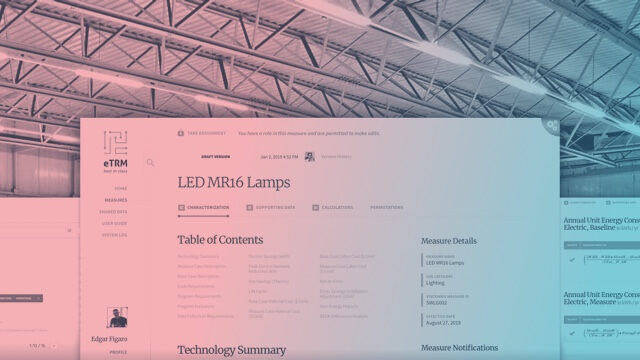Overview
After California passed the Clean Energy and Pollution Reduction Act of 2015, a coalition of utilities hired SBW, an energy efficiency consulting firm and OMBU to design and build the California Electronic Technical Reference Manual (eTRM) – an online platform for creating energy efficiency measures necessary to meet the Act’s ambitious goals.
eTRM allows California utilities to collaborate through the lifecycle of energy efficiency measure development, offering collaborative tools for drafting, reviewing, calculating, versioning and publishing measures, while meeting critical auditing and data security requirements mandated by the California Public Utilities Commission.

OMBU Contributions
- Technology Strategy
- User Experience Design
- Visual Design
- Custom Application Development
- AWS Infrastructure
- REST API
- Equation engine
The Visionary
Prior to eTRM, California utilities drafted energy efficiency measures using Word documents and complex Excel workbooks. Each utility used different conventions, so creating state-wide measures was a complex and error prone reconciliation effort. California utilities needed a centralized and auditable repository where they could collaborate on drafting measures from start to end.
Energy efficiency measures are technical documents with built-in large data sets and calculations. eTRM needed to offer sophisticated data tools, while being able to present measure content clearly, in non-technical terms, to support a wide audience of program implementers, contractors, state regulators, and staff at public and private utilities, each with different data needs and workflows.
Utility Stakeholders
The Solution
Because there was no precedent for such a system, OMBU was commissioned to design this platform from the ground up. The first project phase involved interviews with energy utility engineers to understand the measure drafting process, distill a data model of the system, and produce a detailed functional specification.

eTRM is an end-to-end measure drafting platform, so engineers from different organizations can collaborate in in one place to draft statewide energy measures. It has functions to support measure assignment, drafting and versions, with an audit trail of edits, preventing version collisions. Each measure in the platform can be updated and saved as a new version, so that utilities and staff can review the measure history, and access savings values for different years.
The application has a shared data library with official, validated data sets that measures can selectively import and use, such as standardized lists of building types and climate zones, reducing the need to duplicate data sets and reducing the risk for measure errors. A calculation builder allows measure engineers to build live equations into measures and apply them to loaded datasets.

The hallmark feature of eTRM is the permutation builder, which takes numerical data from statewide lookup tables and uses a built-in calculation engine to model, analyze, and report on a measure’s potential energy savings. The permutation builder is used to apply energy savings equations to permuted sets of varied conditions — often numbering in the hundreds of thousands — wherever a measure may be applicable.
eTRM offers standardized reports as well as a reporting engine for users to create custom reports. Users can create permutation or measure reports, with bookmarking and subscription functionality, where the system emails the user the report data monthly or quarterly.
This project launched in December 2018.
Technology Highlights
![An image mosaic of the eTRM permutation list and the indicator shown to users while permutations are being built]()
Permutation builder
A system that quickly permutes up to hundred of thousands of energy savings calculations to generate estimated energy savings for a measure.
Next Highlight![eTRM features for entering and viewing engineering equations]()
Calculation engine
OMBU’s custom calculation engine computes and permutes values from varied sources within the measure’s datasets.
Next Highlight![Image mosaic of eTRMs PDF generation feature, allowing to export a PDF from a measure's characterization]()
PDF generation
From any measure, a user can download a PDF version of the measure's characterization content, including complex value tables and calculations, in support of offline workflows and review cycles.
Next Highlight![Image mosaic of eTRM's custom report creation screen and the list of application shared reports]()
Reporting
eTRM has a set of standardized measure and permutation reports, and additionally offers functionality for users to create their own reports, with notification capabilities.
Next Highlight![Image mosaic with some of eTRMs versioning features, such as the list of versions for a measure and the actions a user can take on a version.]()
Versioning
Measure developers and end users can easily get the information they need from each measure because it's easy to navigate through all versions in a simple UI.













